| May 2014 | ||
| « Apr 2014 | News | Jun 2014 » |
May 27, 2014
Chaman Red Blend
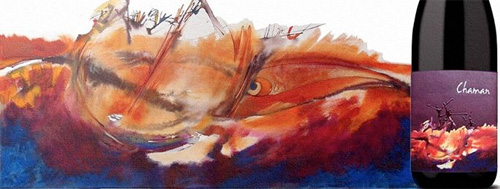
The sorcerers behind Bodega Chaman’s Red Blend are Luis and Pepe Reginato, but the wise man it’s named after is their father, Jose, who has been making magic with grapes for over 50 years. Luis comes with an Argentine pedigree, having been the winemaker for Luca, Tikal, and Catena Zapata. He’s poured his 12+ years of experience into this family project, a Bordeaux blend that is plush and decadent while maintaining balance and complexity.
The wizadry begins at their family’s vineyard in La Consulta: located at 3,543 feet on an alluvial plain in the Uco Valley, its alluvial soils are rocky and sandy with a high calcium content. They are irrigated in the traditional Mendozan way by meltwater from the Andes. The grapes are perfumed and powerful with exceptional acidity. The blend of Cabernet Sauvignon, Cabernet Franc, Malbec, and Petit Verdot (a whopping 55 percent) is aged for 10 months in barrel. Though 50 percent new oak, it’s not overbearing—just completely luxurious.
In fact, the experience of the wine is one of sophisticated luxury. It’s opulent, but not overwrought. The nose offers up funk, wet soil, black cherry, mineral, and dried herbs. The palate is warm and broad, with cherry, brown sugar, and a little vanilla. This wine is a showcase for the majesty of Argentina’s high-altitude winemaking: well-developed flavors with a backbone to support it. Maybe not magic, but some serious winemaking know-how.
May 23, 2014
Tough, Black, and Thick-skinned...
…Tannat is the grape world’s heart of darkness. Formidable indeed, it’s named for its intense tannins, and can be a mouth-gripper if in the wrong hands. But with the right producer, the right terroir, and, often, the right blend, it can offer power and lip-smacking nuance.
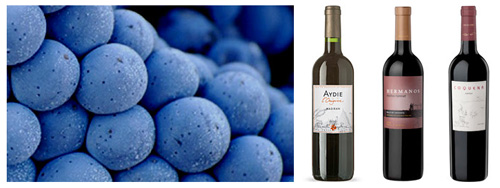
Most famously, it’s the principle grape in the Madrian AOC in the south west of France. There, it’s usually softened by blending with Cabernet Franc, Cabernet Sauvignon, or Fer (Pinenc), and often sees long stretches in oak. Chateau d’Aydie is a pioneer in the region, and has been making wine since before it became an official AOC (in 1948). The domaine’s 2011 ‘L’Origine’ is a blend of 70 percent Tannat and 30 percent Cabernet Franc, grown on clay-limestone slopes with small pebbles. They ferment the grapes separately, then age 80 percent of the final blend in tank and 20 percent in oak barrels for 12 months. The resulting wine has firm, dusty tannins, and a full, floral effect. There is certainly a power to this wine, but with notes of currants, violets, spice, and soil, there’s also a prettiness.
Though generally associated with its French appellation, Tannat is from the Basque region, and made its way to South America via Basque settlers in the 19th century. The South American sun agreed with the grape, and it’s now firmly a part of the continent’s viticulture. Uruguay in particular has embraced it, but it also has a place in Argentina—especially in the Salta region. The high altitudes (highest in the winemaking world!) and intense, plentiful sunshine help make wines with focused aromas and round tannins. The Hermanos de Domingo Molinos Winery blends its Tannat (30 percent) with Malbec to make a lush, savory wine with shockwaves of flavor. Grown at 6,970 feet with 340 days of sunshine, and the benefit of pure mountain water, the grapes are able to build ample acid to balance out their ripeness. In this blend, the Tannat provides structure and precision while the Malbec contributes a plush, velvet texture. It’s full-throttled and inky black, with notes of olive, dried black fruits, smoke, and soil on the nose. The palate is expansive, with notes of licorice, cocoa powder, and spice. The acid is good here, adding a liveliness to what could be a heavy wine.
Also from Salta, the Coquena Winery makes a bold move—and a bold wine—with its 100 percent Tannat. Though it’s not short on muscle, it’s considerably more lush than you might expect. Grown at 5,576 feet, the tannins are round and the wine is rich, with aromas of coffee, dried flowers, spice, chocolate, and blackberry. The depth of flavor and downright smoothness of the texture make this wine a prime example of how the right terroir can tame the wild Tannat beast.
May 22, 2014
FEATURED: 3,000-Mile Region Commands Attention
Last May (2013) Vine Connections launched “The New Chile.” Many of you may remember being visited by Chilean winemakers. Well this May (2014) the cover story of Wine Spectator was “The New Chile.” It appears that Chile’s 250+ wineries are commanding attention on the world stage. And there’s good reason to look now to the 3,000-mile region west of the Andes: with a dedicated organic ethos, completely ungrafted rootstocks, and enthusiastic international investment from top winemakers, Chile’s winemaking is more exciting than ever before. And, after a long focus on affordable varietal wines with hit-or-miss quality, the buzz word is now, finally, terroir.
May 21, 2014
Cream Import Spotlight
Emilia Romagna’s reputation for cuisine is indisputable…but when it comes to wine, it’s historically been on less solid ground. That is, until recently, as an increasing number of excellent wines have been hitting the scene from the Sangiovese di Romagna DOC. By carefully managing yields and plant density, producers have been able to show how distinctive and delicious this specific clone of Sangiovese can be.
After Sangiovese’s PR problem in the mid-twentieth century—the use of Trebbiano as a blending grape did it no favors—producers in central Italy set about systematically studying the grape and its myriad clones. What they found, aside from how extremely sensitive the grape is to terroir and growing conditions, is that the finest clones (R25 and T19) are in fact from Romagna. To underscore the importance of this clone, the Sangiovese di Romagna DOC rules are currently set to change from 80 percent Sangiovese to 95 percent. With excellent raw material and savvy producers, these wines show that this is the most important of the Sangiovese zones outside of Tuscany.
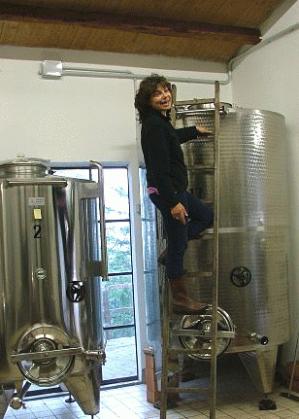 Giovanna Madonia is one such producer. She was introduced to Romagna wine culture by her father, who was elected the first president of the Consortium of Wines of Romagna. She meticulously researched clones and terroir before building her eponymous winery on the hill of Montemaggio in Bertinoro, in the southeastern part of the region. Her vineyards are planted between 650 and 1,000 feet. on calcareous clay soil, with an optimal southwest exposure, then bush-trained to maximize time in the sun. She further controls each factor in the cellar, fermenting in stainless steel then aging for 12 months in French Barriques and Tonneaux.
Giovanna Madonia is one such producer. She was introduced to Romagna wine culture by her father, who was elected the first president of the Consortium of Wines of Romagna. She meticulously researched clones and terroir before building her eponymous winery on the hill of Montemaggio in Bertinoro, in the southeastern part of the region. Her vineyards are planted between 650 and 1,000 feet. on calcareous clay soil, with an optimal southwest exposure, then bush-trained to maximize time in the sun. She further controls each factor in the cellar, fermenting in stainless steel then aging for 12 months in French Barriques and Tonneaux.
Her 2008 Riserva Ombroso is 100 percent Sangiovese from vines planted in 1993. She only makes this wine in the best vintages, and her great care translates into a beautifully balanced varietal expression. It is bright and vivid with excellent acid. The nose exudes tar, tea, mint, and flowers, with violets and cherries on the palate. The finish is long with notes of cherry cordial. This clone is known for softer tannins than its Tuscan counterparts, and the effect here is sumptuous and elegant. This would pair beautifully with so much of the region’s cuisine, but, with taglietelle al ragu, it would sing.
May 13, 2014
Sake Confidential - Save the Date
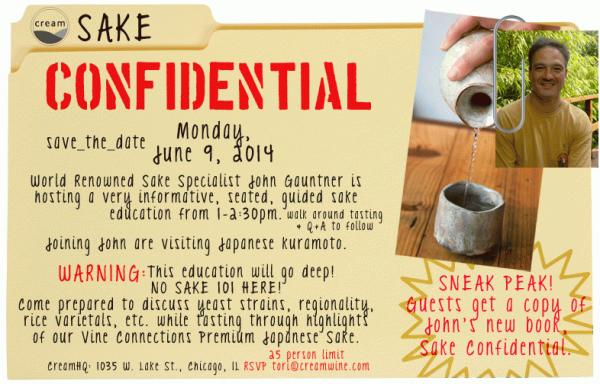 We are proud to welcome world renowned sake specialist John Gauntner to the CreamHQ this June for a special sake education seminar.
We are proud to welcome world renowned sake specialist John Gauntner to the CreamHQ this June for a special sake education seminar.
This is not SAKE 101. John will be accompanied by visiting Japanese kuramoto. They’ll speak about yeast strains, regionality, rice varietals and more. Furthermore, you’ll get a sneak peak at John’s new book Sake Confidential.
Seminar is from 1-2:30pm with walk around tasting and Q&A to follow.
This is a TRADE ONLY EVENT. Seating is limited to 25 people.
If you are interested in attending, please RSVP to tori@creamwine.com. She will confirm your reservation.
May 13, 2014
FEATURED: Call Me Ishmael - Visit to Melville in Sta. Rita Hills
When Ron Melville moved to Santa Barbara from Sonoma in 1989 to set up shop, little did he know that he’d be laying the groundwork for something of an empire. When the Melville family arrived, winegrowing in Santa Barbara County was just on the verge of a boom—10,000+ acres of grapes were planted within the next decade. Twenty-five years later, the region has earned a major reputation for cool-climate varietals, and Melville and his team are at the center of the buzz.
May 09, 2014
Breaking Ground
Brooks is building a new winery and tasting room!
From Janie Brooks: “People often ask me what involvement I had in Brooks before Jimi died. The answer is barely. The one conversation we had on a regular basis was trying to figure out how he could have his own winery. He was tired of working for anyone else and always having Brooks be secondary. It has been a motivating factor with me to get the winery to a place where I can make this dream of his come true. And now, it is happening!
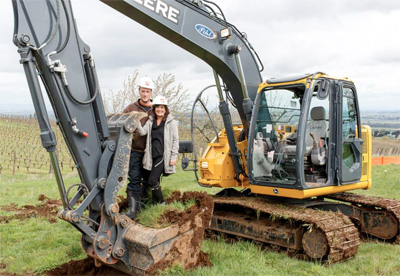 It has taken me 10 years! Last Tuesday, we broke ground on a 12,000 square foot winery and tasting room. The building is going to be on our farm house property on 5 acres with the most amazing view of the Willamette Valley. It is adjacent to our estate vineyard as well. The building is practical and functional but is 5 times the size of our current facility. Bless Chris’ heart who has been playing the tetris game for years to make our wine and probably spends 60+% of his time moving equipment etc around! And he has never complained! I cannot wait to give him a facility that will make his time more aligned with what is important!
It has taken me 10 years! Last Tuesday, we broke ground on a 12,000 square foot winery and tasting room. The building is going to be on our farm house property on 5 acres with the most amazing view of the Willamette Valley. It is adjacent to our estate vineyard as well. The building is practical and functional but is 5 times the size of our current facility. Bless Chris’ heart who has been playing the tetris game for years to make our wine and probably spends 60+% of his time moving equipment etc around! And he has never complained! I cannot wait to give him a facility that will make his time more aligned with what is important!
The grounds will include gardens for all of our biodynamic preparations as well as fruits and vegetables for the team, orchard guilds, ponds and of course the animals/insects…chickens, goats and bees…no cows! After 15 years of moving around, Brooks will finaly have their owne home on their estate with an incredible view of Mt. Hood and the Willamette Valley, their new 13,500 square foot production facility, tasting room and biodynamic gardens.
May 05, 2014
Ciders for Spring & Summer
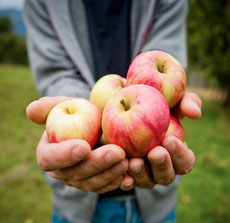 Hard cider has a long history in America, dating back to the Colonial period when it was the most popular beverage in the country. It made its way here with the English settlers, who soon learned that apples were much easier to grow in the New England soil than the barley and grains for beer. By the turn of the 18th century, Americans were drinking an average of 35 gallons of cider per year. There was even a weakened version called Ciderkin for children.
Hard cider has a long history in America, dating back to the Colonial period when it was the most popular beverage in the country. It made its way here with the English settlers, who soon learned that apples were much easier to grow in the New England soil than the barley and grains for beer. By the turn of the 18th century, Americans were drinking an average of 35 gallons of cider per year. There was even a weakened version called Ciderkin for children.
But its heyday didn’t last—and the Midwest is partly to blame. When brewers discovered that the Midwest’s soil was prime for growing barley and grains, beer took off. Plus, a new wave of beer-thirsty immigrants, and, later, Prohibition didn’t help matters any for the humble cider.
Cream carries handcrafted, delicate ciders that will grace the table with as much panache as many a wine. The care and vision involved in each bottle warrants a serious revisiting of this genre that was so popular with our forefathers.
Over the last 25 years, cider has come back with a vengeance—and not just in America. The French, Italians, and Spanish are churning out sophisticated and exciting versions. In Normandy, sommelier-turned-farmer Eric Bordelet makes artisan ciders from heirloom apple and pear trees. He organically farms and handpicks 20 varieties of apples and 14 of pears for complexity and balance. The Art of Eating wrote in issue #87, “his ciders are on a higher level than most others in the region; they have concentration, focus, balance, finesse and, above all, delicious flavors of ripe apples and subtle spice.” (read article here) His Nouvelle Vague is light, refreshing, and pairs beautifully with apple tarte tatin. Try his Brut Tendre with a ham and Gruyere crepe. His Argelette is a premium cider that exudes apricot, lemon, honey, and mild spice, definitely suited to drinking alongside cheese.
 In the Alpine Italian region of Valle d’Aosta, the Maley Cider Project (new to our portfolio; talk with your Cream Rep about pricing and availability) makes cider in the both the Methode Traditionelle (or Champenoise method) and Methode Ancestral (using all indigenous yeast). The century-old orchards in the region generate fruits surprisingly adapted to produce cider, with suitable characteristics of acidity, tannins, and sugar concentration. We carry a version of each with characteristics of apple and white blossom aromas and the grace to accompany rich fondue as a refreshing counterpoint.
Maley Apple Cider Jorasses Methode Traditionelle
Maley Cidre du Mont Blanc Methode Ancestral
In the Alpine Italian region of Valle d’Aosta, the Maley Cider Project (new to our portfolio; talk with your Cream Rep about pricing and availability) makes cider in the both the Methode Traditionelle (or Champenoise method) and Methode Ancestral (using all indigenous yeast). The century-old orchards in the region generate fruits surprisingly adapted to produce cider, with suitable characteristics of acidity, tannins, and sugar concentration. We carry a version of each with characteristics of apple and white blossom aromas and the grace to accompany rich fondue as a refreshing counterpoint.
Maley Apple Cider Jorasses Methode Traditionelle
Maley Cidre du Mont Blanc Methode Ancestral
Looking for a pétillant naturel cider? Jean-Yves Peron has produced a cider that feels like an orchard in your mouth…apple skins, complex, clean acid. Try his ‘Cidre des Cimes’ with Savoie cheese while picnicking.
Stateside, in Santa Cruz, California, Bonny Doon makes ‘Querry’ Cider: a bone-dry apple, pear, and quince cider that is produced with indigenous yeast and has crisp acidity and bold aromatics that match Asian food.
May 02, 2014
Huet Petillant - Pleasurable Vouvray sparkler
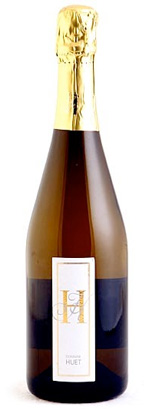 The 2009 Vouvray Petillant Brut from Domaine Huet is a sophisticated and immensely pleasurable sparkler. From one of Vouvray’s stalwart producers, this pale, honey-colored wine expresses the ripeness of a warm vintage and the nuance in which Chenin Blanc is capable. It opens on a chalky nose with notes of honey and juicy pear, and gives way to a medium-weight, round palate, with subtle hints of beeswax and yeastiness. The finish is dry and clean. Though petillant often suggests a very soft effervescence, the mousse in this bottle is quite fine and lively. This is clearly a deftly crafted wine from a seasoned producer.
The 2009 Vouvray Petillant Brut from Domaine Huet is a sophisticated and immensely pleasurable sparkler. From one of Vouvray’s stalwart producers, this pale, honey-colored wine expresses the ripeness of a warm vintage and the nuance in which Chenin Blanc is capable. It opens on a chalky nose with notes of honey and juicy pear, and gives way to a medium-weight, round palate, with subtle hints of beeswax and yeastiness. The finish is dry and clean. Though petillant often suggests a very soft effervescence, the mousse in this bottle is quite fine and lively. This is clearly a deftly crafted wine from a seasoned producer.
The domaine was founded in 1928 by Victor Huet, a Parisian bistro owner who moved to the Loire to calm his WWI-rattled nerves. It has since been passed down to his son, his grandson-in-law, and now Cellarmaster Jean-Bernard Berthomé. Part of their success is their exceptional landholding: their three major parcels (Le Haut-Lieu, Le Mont, and Clos du Bourg) are home to virtually all of the appellation’s acknowledged grand cru vineyards. All of the estate vineyards lie on limestone-rich clay soils, which yield wines of intensity and great longevity. Heut practices biodynamic viticulture. The estate’s Petillant is made from grapes in the “Big 3” vineyards, plus other small nearby parcels.It is fermented in oak casks and stainless steel tanks, then kept on its lees for at least 16 months.
The Petillant would pair beautifully with an appetizer like prosciutto al melone, or would be a great brunch accompaniment with eggs benedict. For dinner, match it up with a sweet potato soup or shrimp tempura. It is decidedly food-friendly, though its enchantments shine on their own.
